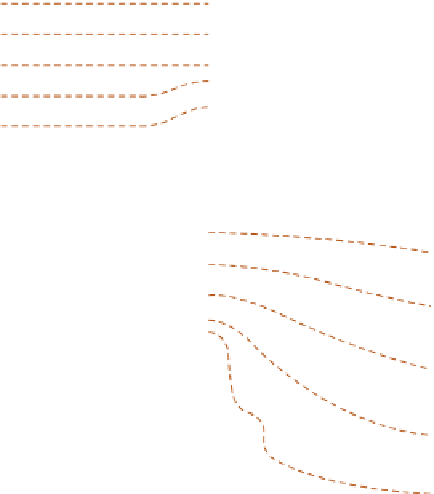Geoscience Reference
In-Depth Information
(a)
and
boundary shear stress
,
o
, is defined as:
o
=
gRS
where
gravitational acceleration) and
Q
,
R
and
S
are standard
parameters used above. Boundary shear stress multiplied
by mean velocity gives the
specific
stream power:
g
is the
specific weight
of water (density
=
o
v
mean
(b)
and is high (over 1 kW m
-2
) in steep, high-discharge
rivers and low (under 100 W m
-2
) in gentle, low-discharge
rivers. This confirms the importance of channel efficiency
in establishing a
power threshold
, at which available power
is just sufficient to overcome friction resistance to mean
water and sediment discharge. Below this threshold, the
stream deposits a proportion of its sediment load to
restore efficiency. Above the threshold, the stream actively
erodes its channel.
Channel networks
Groundwater flow lines
Lines of equipotential gravity flow
Principles of channel process and form extend from
individual segments to the entire river and, indeed, the
drainage basin. Downstream changes discussed so far are
applied later to the geomorphological development of
fluvial landsystems, after first reviewing their significance
for the basin-wide
network
. Drainage networks are
organized systems of channels which transfer water and
sediment, in incremental amounts, through the catchment
via a definite sequence (e.g. rills
qgullies qtributary
river channels qtrunk rivers). Networks possess measur-
able order (hierarchy), density and pattern, and reflect
the principal catchment attributes, including stage of
development and catchment shape.
Stream order
recognizes the nature and development
of channel hierarchy as more aggressive channels 'capture'
neighbours. Having looked earlier at how rills focus flow
in a downslope manner, upslope and lateral development
extend this simple model. Local convergence of water in
the channel, from (ideally) isotropic or
equipotential
throughflow or overland flow, causes
spring sapping
and
headward retreat
of the point of initiation. This may
continue via branching until the remaining catchment
area is too small to feed any additional channels (
Figure
streams lacking tributaries as
first-order
streams and each
sequential stream by either arithmetic progression (2, 3,
etc.) or as the sum of feeder streams. Shrève's scheme is
preferred to Strahler's, which fails to recognize the scale
Figure 14.16
Spring sapping and drainage network devel-
uniform land surface initiates local convergence of flow lines
(a), spring sapping and headward retreat (b).
Source: After Knighton (1984)
of increasing discharge, although it is thought to generate
a number of useful correlations between river connectivity
and the catchment (
Figure 14.17
).
Drainage density
,
D
d
, refers to the channel length (
L
)
draining a unit area (
A
):
D
d
=
L
/
A
and reflects catchment variables, channel network
efficiency and maturity. In hydrometeorological terms,
higher drainage densities are associated with higher mean
annual precipitation, or strongly seasonal regimes, but
correlations are far from simple. High densities may also
be found in semi-arid areas where lack of vegetation cover
compensates for lower rainfall. Drainage density increases
during wet spells, as the permanent network expands to
incorporate intermittent channels. Geology influences
drainage density, which is inversely proportional to


































































































































